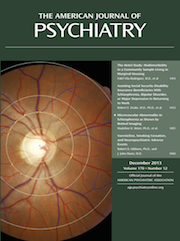Drug-Induced Long QT in Adult Psychiatric Inpatients: The 5-Year Cross-Sectional ECG Screening Outcome in Psychiatry Study
Abstract
Objective
The authors aimed to determine the prevalence of drug-induced long QT at admission to a public psychiatric hospital and to document the associated factors using a cross-sectional approach.
Method
All ECG recordings over a 5-year period were reviewed for drug-induced long QT (heart-rate corrected QT ≥500 ms and certain or probable drug imputability) and associated conditions. Patients with drug-induced long QT (N=62) were compared with a sample of patients with normal ECG (N=143).
Results
Among 6,790 inpatients, 27.3% had abnormal ECG, 1.6% had long QT, and 0.9% qualified as drug-induced long QT case subjects. Sudden cardiac death was recorded in five patients, and torsade de pointes was recorded in seven other patients. Relative to comparison subjects, patients with drug-induced long QT had significantly higher frequencies of hypokalemia, hepatitis C virus (HCV) infection, HIV infection, and abnormal T wave morphology. Haloperidol, sertindole, clotiapine, phenothiazines, fluoxetine, citalopram (including escitalopram), and methadone were significantly more frequent in patients with drug-induced long QT. After adjustment for hypokalemia, HCV infection, HIV infection, and abnormal T wave morphology, the effects of haloperidol, clotiapine, phenothiazines, and citalopram (including escitalopram) remained statistically significant. Receiver operating characteristic curve analysis based on the number of endorsed factors per patient indicated that 85.5% of drug-induced long QT patients had two or more factors, whereas 81.1% of patients with normal ECG had fewer than two factors.
Conclusions
Drug-induced long QT and arrhythmia propensity substantially increase when specific psychotropic drugs are administered to patients with hypokalemia, abnormal T wave morphology, HCV infection, and HIV infection.



